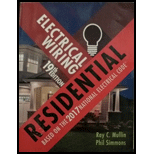
ELECTRICAL WIRING:RESIDENT.-TEXT (PB)
19th Edition
ISBN: 9781337116213
Author: MULLIN
Publisher: CENGAGE L
expand_more
expand_more
format_list_bulleted
Concept explainers
Question
Chapter 19.2, Problem 15R
To determine
State the reason why the storage tank holds the heat for a long period.
Expert Solution & Answer
Trending nowThis is a popular solution!

Students have asked these similar questions
DO NOT NEED AI WILL REJECT
1
6. Root locus for a closed-loop system with L(s)
is shown below.
s(s+4)(s+6)
DO NOT NEED AI WILL REJECT
Chapter 19 Solutions
ELECTRICAL WIRING:RESIDENT.-TEXT (PB)
Ch. 19.1 - Does a jet pump have any electrical moving parts...Ch. 19.1 - Prob. 2RCh. 19.1 - Where is the jet of the pump located?...Ch. 19.1 - Prob. 4RCh. 19.1 - Prob. 5RCh. 19.1 - Prob. 6RCh. 19.1 - Prob. 7RCh. 19.1 - What is compressed in the water storage tank?...Ch. 19.1 - Explain the difference between a 2-wire...Ch. 19.1 - Prob. 10R
Ch. 19.1 - Why is a 240-volt motor preferable to a 120-volt...Ch. 19.1 - How many amperes does a 1-horsepower, 240-volt,...Ch. 19.1 - What size are the conductors used for this branch...Ch. 19.1 - Prob. 14RCh. 19.1 - What provides the running overload protection for...Ch. 19.1 - What is the maximum ampere setting permitted for...Ch. 19.1 - Prob. 17RCh. 19.1 - Because the controller contains the motor starting...Ch. 19.1 - Prob. 19RCh. 19.1 - Proper pressure of the submersible pump system is...Ch. 19.1 - Fill in the data for a 16-ampere electric motor,...Ch. 19.1 - The NEC is very specific in its requirement that...Ch. 19.1 - Does the NEC allow submersible pump cable to be...Ch. 19.1 - Must the disconnect switch for a submersible pump...Ch. 19.1 - A metal well casing (shall) (shall not) be bonded...Ch. 19.2 - Prob. 1RCh. 19.2 - A major hazard involved with water heaters is that...Ch. 19.2 - Prob. 3RCh. 19.2 - The heating elements in electric water heaters are...Ch. 19.2 - An 80-gallon electric water heater is energized...Ch. 19.2 - Prob. 6RCh. 19.2 - For residential water heaters, the Consumer...Ch. 19.2 - An 80-gallon electric water heater has 60F...Ch. 19.2 - Approximately how long would it take to produce...Ch. 19.2 - Two thermostats are generally used in an electric...Ch. 19.2 - a. How many heating elements are provided in the...Ch. 19.2 - When does the lower heating element operate?...Ch. 19.2 - Prob. 14RCh. 19.2 - Prob. 15RCh. 19.2 - Prob. 16RCh. 19.2 - a. If both elements of the water heater in this...Ch. 19.2 - a. How much power in watts would the two elements...Ch. 19.2 - A condominium owner complains of not getting...Ch. 19.2 - For a single, nonmotor-operated electrical...Ch. 19.2 - A 7000-watt resistance-type heating appliance is...Ch. 19.2 - Prob. 22R
Knowledge Booster
Learn more about
Need a deep-dive on the concept behind this application? Look no further. Learn more about this topic, electrical-engineering and related others by exploring similar questions and additional content below.Similar questions
- 5. Sketch the root locus for L(s) = s+10 using rules 1, 2, and 4. For rule 4, you need to s(s+6) find the break-in and break-away points.arrow_forwardS+4 4. Sketch the root locus for L(s) = (s+6) (s+1)2 using rules 1, 2, and 3. For rule 3, you need to find the value of σ and a for the asymptotes. From the root-locus, explain why the closed-loop system is always stable for any choice of the design parameter K in the range 0 < K < ∞o.arrow_forward2. Consider the following system. K(s+3) (s+4) (s+1)(s+2) Check whether the points below are in the root locus. If the point is in the root locus, then also find what the corresponding gain K. i) ii) -2+j3 -2+1√ √ Hint: First find L(s). Next, in L(s) replace s with the value of the point and then express it in polar format r20 using calculator. The point will be in the root locus if and only if = 180° or odd multiple of 180°. When the point is in the root locus, the corresponding gain K is obtained as K ==arrow_forward
- 2. For each of the following transfer functions, G(s) = Y(s)/U(s), find the differential equation relating the input u(t) to the output y(t). (s+2)(s+3) (a) G(s) = (s+1)(s+4) (s²+0.4s+1.04) (s+3) (b) G(s)= (s2+0.2s+1)(s+2)(s+4)arrow_forwardDon't use ai to answer I will report you answerarrow_forward5. A schematic diagram of a motor connected to a load by gears is shown. Both the motor and the load are modeled as rotating masses with viscous damping. Find the transfer functions Øm/Tm and ØL/Tm. bm Jm Tm 0m N₂ N₁ OL но JL b₁arrow_forward
- 3. Find the transfer function X2/F of the mechanical system in Figure. Κι www b₁ M₁ K2 www M2 b2 X2 F b3arrow_forwardS1(t) Es/Ts 0 S3(t) 0 Es/Ts Ts t S2(t) Es/Ts 0 Es/Ts Ts |7|2 S4(t) Es/Ts t Ts t 0 Ts Ts Ts Es/TS 2 1/ Q1(t) 42(t) Ts 1JT 0 t 0 Ts Ts 2 32 FIGURE 7.3 Set of signals and orthonormal functions for Example 7.1. 53(t)=√√Esq₁(t) S4(t)=-√E542(t) t Tsarrow_forward1. For each of the following differential equations, determine the transfer function Y/U. Determine if the transfer function is proper or strictly proper. is not strictly proper, determine the strictly proper part. If it (a) y(3) = -3y(2) - 3y(1) — 2y + u(2) — - (b) y(3)=-3.5y(2) — 3.5y(1) — y +u(3) — 3.5u(2) + 3.5u(¹) + 3uarrow_forward
arrow_back_ios
SEE MORE QUESTIONS
arrow_forward_ios
Recommended textbooks for you
 EBK ELECTRICAL WIRING RESIDENTIALElectrical EngineeringISBN:9781337516549Author:SimmonsPublisher:CENGAGE LEARNING - CONSIGNMENT
EBK ELECTRICAL WIRING RESIDENTIALElectrical EngineeringISBN:9781337516549Author:SimmonsPublisher:CENGAGE LEARNING - CONSIGNMENT

EBK ELECTRICAL WIRING RESIDENTIAL
Electrical Engineering
ISBN:9781337516549
Author:Simmons
Publisher:CENGAGE LEARNING - CONSIGNMENT